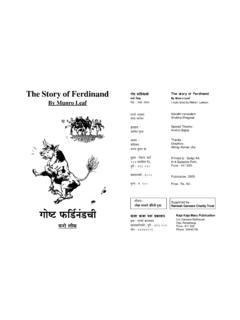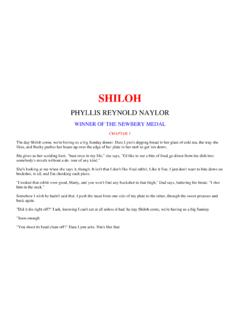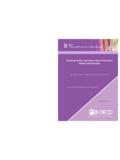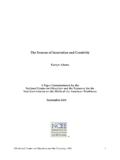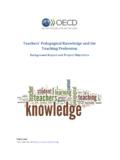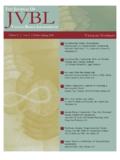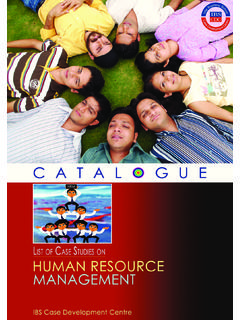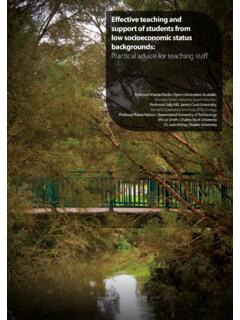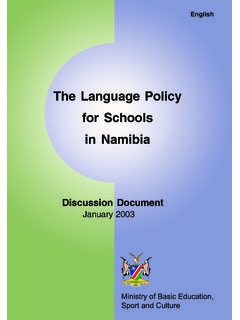Transcription of The Montessori Method - ArvindGuptaToys Books …
1 The Montessori Method This page was intentionally left blank The Montessori Method The Origins of an Educational innovation : Including an Abridged and Annotated Edition of Maria Montessori s The Montessori Method Maria Montessori , edited by Gerald Lee Gutek ROWMAN & LITTLEFIELD PUBLISHERS, INC. Lanham Boulder New York Toronto Oxford ROWMAN & LITTLEFIELD PUBLISHERS, INC. Published in the United States of America by Rowman & Littlefield Publishers, Inc. A wholly owned subsidiary of The Rowman & Littlefield Publishing Group, Inc. 4501 Forbes Boulevard, Suite 200, Lanham, MD 20706 Box 317, Oxford OX2 9RU, UK Copyright 2004 by Rowman & Littlefield Publishers, Inc. All rights reserved. No part of this publication may be reproduced, stored in a retrieval system, or transmitted in any form or by any means, electronic, mechanical, photocopying, recording, or otherwise, without the prior permission of the publisher.
2 British Library Cataloguing in Publication Information Available Library of Congress Cataloging-in-Publication Data Montessori , Maria, 1870 1952. [Metodo della pedagogia scientifica. English] The Montessori Method : the origins of an educational innovation , including an abridged and annotated edition of Maria Montessori s The Montessori Method / Maria Montessori ; edited by Gerald Lee Gutek. p. cm. Includes bibliographical references and index. ISBN 0-7425-1911-2 (cloth : alk. paper) ISBN 0-7425-1912-0 (pbk. : alk. paper) 1. Montessori Method of education. 2. Education, Preschool Philosophy. 3. Montessori , Maria, 1870 1952. 4. Women educators Italy Biography. I. Gutek, Gerald Lee. II. Title. 2004 '2 dc22 2004000420 Printed in the United States of America The paper used in this publication meets the minimum requirements of American National Standard for Information Sciences Permanence of Paper for Printed Library Materials, ANSI/NISO For my grandchildren, Abigail Lee and Luke Kenneth Swiatek, and their parents, Laura Lee and Andrew Swiatek.
3 This page was intentionally left blank Contents Editor s Note ix Introduction: A Biography of Montessori and an Analysis of the Montessori Method 1 Part I: An Annotated Edition of Maria Montessori s The Montessori Method 1 A Critical Consideration of the New Pedagogy in Its Relation to Modern Science 69 2 History of methods 3 Inaugural Address Delivered on the 81 Occasion of the Opening of One of the Children s Houses 93 4 Pedagogical methods Used in the Children s Houses 107 5 Discipline 113 6 How the Lessons Should Be Given 123 7 Exercises of Practical Life 129 8 Refection The Child s Diet 133 9 Muscular Education Gymnastics 135 vii viii Contents 10 Nature in Education Agricultural Labor: Culture of Plants and Animals 143 11 Manual Labor The Potter s Art and Building 149 12 Education of the Senses 153 13 Education of the Senses and Illustrations of the Didactic Material: General Sensibility; the Tactile, Thermic, Baric, and Stereognostic Senses 161 14 General Notes on the Education of the Senses 177 15 Intellectual Education 181 16 methods for the Teaching of Reading and Writing 195 17 Description of the Method and Didactic Material Used 205 18 Language in Childhood 227 19 Teaching of Numeration: Introduction to Arithmetic 233 20 Sequence of Exercises 243 21 General Review of Discipline 249 22 Conclusions and Impressions 261 Part II: Related Documents23 Interpretation of Montessori s Lecture 267 Translated by Anne E.
4 George 24 Excerpts from The Montessori System Examined 273 William H. Kilpatrick Appendix 279 Bibliography 283 Index 285 About the Editor 295 Editor s Note Maria Montessori and the Montessori Method : The Origins of an Educa tional innovation creates the context in which Maria Montessori developed her philosophy of early childhood education. It examines how a determined young woman overcame the obstacles that blocked the educational and career opportunities in Italy during the late Victorian age. Following Montessori , who was the first woman to earn a medical degree from the University of Rome, the biographical introduction takes her story to the establishment of the first Montessori school, the Casa dei Bambini in the slums of Rome. It then analyzes the sources and influences that shaped the creation of the Montessori philosophy of education. Special attention is given to The Montessori Method as the book that introduced this educational innovation to an American audience.
5 This book is divided into several sections. It begins with a biography of Maria Montessori and an introductory commentary on the Montessori Method of Education. Part I contains an abridged and annotated edition of Maria Montessori s Montessori Method (1912). Part II contains related documents. The biography of Montessori (1870 1952) discusses her family, educa-tion, career in medicine and education, establishment of the first Montessori school, Casa dei Bambini in Rome, the development of her philosophy and Method of education, her lecture tour in the United States in 1913, and sub-sequent events in her life. In examining Montessori s development of her ed-ucational Method , it treats the influence of her medical education, especially the importance given to clinical observation and the use of science. The in-fluence of Itard and Seguin, two French physicians and educators, who de-veloped methods for educating children with physical and mental handicaps ix x Editor s Note is discussed.
6 An important section of the biography deals with the first at-tempt to introduce the Montessori Method of the United States in 1913, es-pecially the efforts of the publicist and journalist, S. S. McClure and Anne E. George, the first American trained by Montessori . The essay follows Montessori from the time of the American lecture tour, to her work in Eu-rope and Asia. The commentary on the Montessori Method analyzes how her medical edu-cation exercised an influence on her work in education. It then analyzes her concept of the child, children s sensitive developmental periods, the education of the senses, practical skills, and the child s explosion into reading and writ-ing. The Montessori curriculum and didactic materials are discussed. The sec-tion concludes with Montessori s ideas on moral development and education. Part I is an annotated and abridged edition of Maria Montessori s, The Montessori Method .
7 This English language translation by Anne E. George is highly important in the Montessori literature because it served as the first ma-jor introduction to her Method in the United States. When read as a back-ground to her first lecture tour of the United States, it provides a clear and de-tailed discussion of the Montessori Method . The book became a best-selling nonfiction work in the year of its publication. The editor provides a series of explanatory notes to persons and trends mentioned by Montessori . Part II provides two related documents: (1) Anne E. George s notes that were used in the translation of Montessori s lectures into English during the 1913 speaking tour arranged by the American publisher S. S. McClure; (2) se-lected critical excerpts from William H. Kilpatrick s The Montessori System Examined (1914). George, trained as a directress by Montessori , was a lead-ing proponent of the Method in the United States.
8 She established the first American Montessori school at Tarrytown, New York. Kilpatrick, a professor of education at Columbia University s Teachers College, was a disciple of John Dewey s Pragmatist philosophy. A leading progressive educator, Kil-patrick was highly critical of the Montessori Method . NOTE Page number references (indicating deletion) in editor s notes refer to Montessori s original (1912). Introduction: A Biography of Montessori and an Analysis of the Montessori Method BIOGRAPHY Today, Maria Montessori enjoys global acclaim as one of the world s great educators. Her life story is a remarkable one one in which a dedicated woman used her scientific training, her experience, and her insights to de-velop a Method of education that challenged conventional patterns of educa-tion. The conventions she challenged were not only educational ones: she had to surmount the obstacles that limited the freedom of women to enter into new careers.
9 Maria Montessori was born on August 31, 1870, in Chiaravalle, a hill town overlooking the Adriatic Sea, in Italy s Ancona province. She was the only child of Alessandro Montessori , a business manager in the state-run tobacco monopoly; and Renilde Stoppani, the well-educated daughter of a highly re-spected Maria Montessori was born only ten years after Italy s unification, under the House of Savoy. As a result of the Risorgimento, led by Camillo Cavour, a liberal statesman, and Giuseppe Garibaldi, a fiery patriot, the small states and principalities on the Italian peninsula were finally united as one country in 1871. Giuseppe Garibaldi s red-shirted volunteer army, the Car-bonari, had toppled the old bourbon kingdom of the Two Sicilies, and the armies of Piedmont-Sardinia had brought Victor Emmanuel to Italy s throne as a constitutional monarch. The new Italy was a product of the forces of nationalism and liberalism.
10 Nationalists, such as Garibaldi, wanted Italy to take its place in the political sun. Liberals such as Cavour wanted to move Italy forward as a modern in-dustrialized nation. Strong remnants of conservatism and traditionalism, 1 2 Introduction however, resisted Italy s modernization. Serious opposition came from the pope, who, smarting from the annexation of the Papal States to Italy and re-garding himself as the prisoner of the Vatican, refused to recognize the new political reality. Maria Montessori s uncle, Antonio Stoppani, a noted naturalist and Roman Catholic priest, called for reconciliation between church and state. Maria s father, Alessandro, while remaining a committed Catholic, took a position in the new state s civil service. Although Italy s emergence as a sovereign nation was recent, Italian cul-ture reached back to the antiquity of ancient Rome. The new nation in which Montessori was born, in 1870, remained still very much the old, traditional, and conservative Italy.





